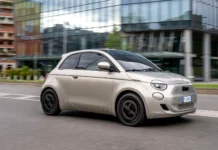
The 2013 Goodwood Festival of Speed, an annual event to showcase automobiles new and old on an uphill race course, got a surprise from Porsche. An 887 horsepower hybrid known as the Porsche 918 Spyder tore up the hill to the admiring cheers of the crowd. The Porsche 918 promises to be one of the most exciting and unique Porsches to date.
The Porsche 918 Spyder has a vast array of settings to maximize the full potential of its technology:
“From comfortable to race-ready: five modes for three motors
The core of the 918 Spyder concept is its distribution of propulsive power among the three power units, and their co-operation is controlled by an intelligent management system. To best exploit these different approaches, Porsche engineers defined five operating modes that can be activated via a ‘map switch’ on the steering wheel, just like a race car. On the basis of this pre-selection, the 918 Spyder applies the most suitable operating and boost strategy without driver intervention, thus allowing the driver to concentrate fully on the road.
Quiet and elegant: ‘E-Power’
When the vehicle is started up, ‘E-Power’ is the default operating mode as long as the battery is sufficiently charged. In ideal conditions, the 918 Spyder can cover over 18 miles (30 km) on purely electric power. Even in pure electric mode, the 918 Spyder accelerates from 0 – 62 mph in less than seven seconds and can reach speeds of up to 93 mph. In this mode, the combustion engine is only used when needed. If the battery’s charge state drops below a set minimum value, the vehicle automatically switches to hybrid mode.
Efficient and comfortable: ‘Hybrid’
In ‘Hybrid’ mode, the electric motors and combustion engine work alternately with a focus on maximum efficiency and minimum fuel consumption. The use of individual drive components is modified as a function of the current driving situation and the desired performance. The Hybrid mode is typically used for a fuel economy-oriented driving style.
Sporty and dynamic: ‘Sport Hybrid’
In more dynamic situations, the 918 Spyder selects the “Sport Hybrid” mode for its power sources. The combustion engine now operates continuously and provides the main propulsive force. In addition, the electric motors provide support in the form of electric boosting or when the operating point of the combustion engine can be optimised for greater efficiency. The focus of this mode is on performance and a sporty driving style at top speed.

For fast laps: ‘Race Hybrid’
‘Race Hybrid’ is the mode for maximum performance and an especially sporty driving style. The combustion engine is chiefly used under high load, and charges the battery when the driver is not utilising its maximum output. Again, the electric motors provide additional support in the form of boosting. Furthermore, the gear-shifting programme of the PDK is set up for even sportier driving. The electric motors are used up to the maximum power output limit to deliver the best possible performance for the race track. In this mode, the battery charge state is not kept constant, but instead fluctuates over the entire charge range. In contrast to ‘Sport Hybrid’ mode, the electric motors run at their maximum power output limit for a short time for better boosting. This increased output is balanced by the combustion engine charging the battery more intensively. Electric power is thus available even with several very fast laps.
For pole position: ‘Hot Lap’
The ‘Hot Lap’ button in the middle of the map switch releases the final reserves of the 918 Spyder and can only be activated in ‘Race Hybrid’ mode. Similar to a qualification mode, this pushes the traction battery to its maximum power output limits for a few fast laps. This mode uses all of the available energy in the battery.
Main propulsion: the race car’s eight cylinder engine
The main source of propulsion is the 4.6-litre, eight cylinder engine that produces 612 hp of power. The engine is derived directly from the power unit of the successful RS Spyder, which explains why it can deliver engine speeds of up to 9,150 rpm. Like the race engine of the RS Spyder, the 918 Spyder power unit features dry-sump lubrication with a separate oil tank and oil extraction. To save weight, components such as the oil tank, the air filter box integrated into the subframe and the air induction are made of carbon fibre reinforced polymer. Further extensive lightweight design measures have resulted in such features as titanium connecting rods, thin-wall low-pressure casting on the crank case and the cylinder heads, a high-strength lightweight steel crankshaft with 180 degrees crankpin offset and the extremely thin-walled alloy steel/nickel exhaust system.” – – Porsche Media
I am overwhelmed at the potential of the Porsche 918. Not only is it a technological juggernaut, it represents fresh thinking and a willingness to build something courageous, like back in the days of the Porsche 959. Fortunately, the Porsche 918 is drop-dead gorgeous, whereas the 959 wasn’t.
Speaking of German cars, check out Roman and I as we shred the pavement with the

Specifications of the Porsche 918 Spyder
Body: Two-seat Spyder; carbon fibre reinforced plastics (CFRP) monocoque interlocked with CFRP unit carrier; two-piece Targa roof; fixed roll-over protection system
Drivetrain: Parallel full hybrid; 4.6-litre V8 mid-engine with dry-sump lubrication; hybrid module with electric motor and decoupler; electric motor with decoupler and gear unit on front axle; auto start/stop function; electrical system recuperation; four cooling circuits for motors, transmission and battery; thermal management
Engine power: 608 hp (447 kW) at 8,600/min (V8 engine)
115 kW (hybrid module on rear axle)
95 kW (electric motor on front axle)
887 hp (combined)
Max. torque: 530 Nm at 6.600/min (V8 engine)
1,275 Nm (crankshaft equivalent combined, 7th gear)
1,086 Nm (combined, 3rd gear)
> 800 Nm (800/min – 5.000/min)
Maximum Revs: 9,150 rpm
Power output per l: 132 hp/l (V8 engine)
Power transmission: Combustion engine with hybrid module and transmission bolted together to form a single drive unit; seven-speed Doppelkupplungsgetriebe (PDK); rear-wheel drive; front electric motor with gearbox for driving the front wheels (decoupled from 235 km/h); five pre-selectable operating modes for optimum coordination of all drive units
Gear ratios PDK
1st gear 3.91
2nd gear 2.29
3rd gear 1.58
4th gear 1.19
5th gear 0.97
6th gear 0.83
7th gear 0.67
R gear 3.55
Final drive ratio 3.09
Clutch diameter 220 mm / 164 mm
Chassis and Suspension: Double-wishbone front axle; optional electro-pneumatic lift system on front axle; electro-mechanical power steering; multilink rear axle with adaptive electro-mechanical system for individual rear wheel steering; electronically controlled twintube gas-pressure dampers in the front and rear with Porsche Active Suspension Management (PASM)
Brake system: High-performance hybrid brake system with adaptive recuperation; internally ventilated and perforated front ceramic brake discs (PCCB), 410 mm in diameter and 36 mm thick; rear discs 390 mm in diameter and 32 mm thick
Wheels and tyres: 918 Spyder wheels (Weissach package: 918 Spyder magnesium wheels)
front 9.5 J x 20 with 265/35 ZR 20
rear 12.5 J x 21 with 325/30 ZR 21
Weights:
Kerb weight, DIN 1,640 kg (‘Weissach’ package)
Dimensions:
Length 4,643 mm
Width 1,940 mm
Height 1,167 mm
Wheelbase 2,730 mm
Track width front 1,664 mm, rear 1,612 mm
Luggage compartment capacity, VDA ~ 110 litres
Fuel tank capacity 70 litres
Energy supply: Lithiumion battery with 6.8 kWh capacity (BOL nominal), 220 kW maximum power and mains-compatible plug-in charger.
Performance:
Top speed > 340 km/h (211 mph)
purely electric 150 km/h (93 mph)
Acceleration:
0 – 62 mph 2.8 s
0 – 124 mph 7.9 s
0 – 186 mph 23.0 s
Consumption (NEDC): Total ~ 3.3l/ 100km (85.6 mpg)
CO2 emissions: Total ~ 79 g/km
Range: Purely electric approx. 30 km (18 miles)
Warranty: Vehicle 4 years, Battery 7 years

























